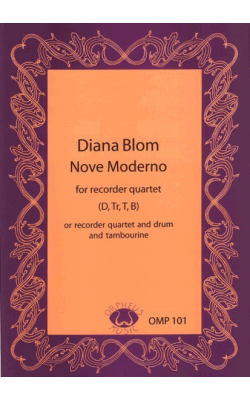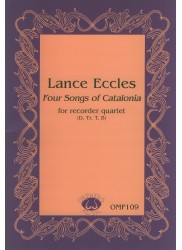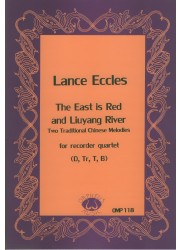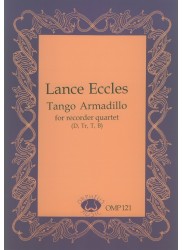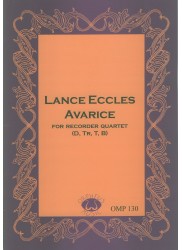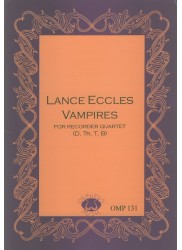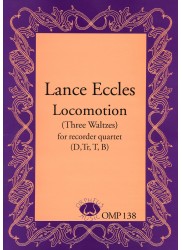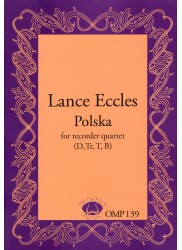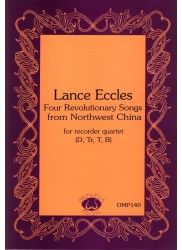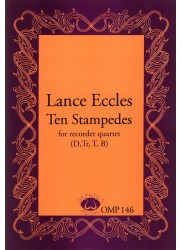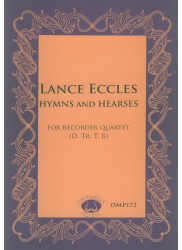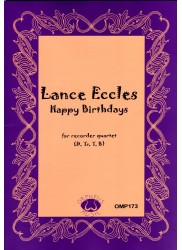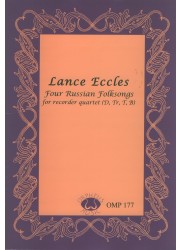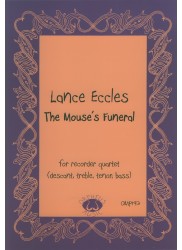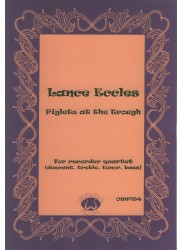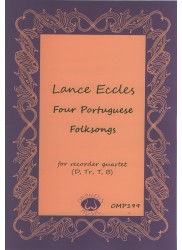No products
Prices are tax included
Nove Morderno
OMP101.pdf
PLEASE NOTE - DOWNLOADABLE PDF VERSION ONLY
Composer: Blom - Diana
Instrumentation: Descant - Treble - Tenor - Bass
Period/genre: Australian Contemporary
Grade: Difficult
More info
*Contemporary Piece.* Lively set of variations. Lots of interesting rhythms and timbres. Optional percussion part.
Please note that due to the automated delivery of virtual products including pdf downloads, PayPal payment is required at the checkout - we are unable to accept the cheque payment method for these items.
_Score 20 pp. Parts 4 pp. Downloadable PDF file._
OMP101 Diana Blom Nove Moderno
Diana Blom is a composer and keyboard player who teaches in the School of Contemporary Arts, University of Western Sydney. The work is presented for descant, treble, tenor and bass recorders with optional parts for drum and tambourine. Although there are written parts for each instrument and much of the instrumental writing is homophonic, the playing score will greatly assist rehearsals. The work is built on a nine bar motif which can be seen in various guises. The rhythmic intensity is kept by the juxtaposition of 3 crotchet beats against 6 quaver beats. I don't feel that the percussion additions are necessary, as the recorder writing is already colourful and rhythmically interesting. This work will pose challenges to quartets through the rapid changes of the metre, but will prove enjoyable in rehearsals and concerts.
Patrick Richmond, The Recorder Magazine Summer 2003 Vol. 23 no. 2
OMP101 Diana Blom Nove Moderno
Nove Moderno, by Australian composer Diana Blom, is at one level an etude in a type of mixed-meter playing: specifically, where a measure of six eighth notes is sometimes divided into two groups of three or sometimes three groups of two. That is, it alternates between 3/4 and 6/8. A list of pieces with similar rhythmic patterns (hemiola) would include early music classics such as Dowland's "The Earl of Essex Galliard" and also some 20th century music such as Leonard Bernstein's "America" from West Side Story.
An ensemble wishing to prepare itself to play this type of music would greatly benefit from working together on Blom's Nove Moderno. It begins with the whole ensemble switching together from one meter to the other, with only the simplest subdivisions. Smaller and more complicated subdivisions (sixteenth notes) enter, and ultimately complicated subdivisions in both 3/4 and 6/8 are performed simultaneously by different instruments. The key to a successful performance might be a shared pulse of one beat per bar in the (inaudible) background.
The score also contains an optional, but very independent, snare drum and tambourine part - only rarely does it have the same rhythm as any of the recorders. The publisher's web site labels this as a "moderately difficult" piece, but the percussion part is perhaps hardest of all.
Putting aside mechanical rhythmic considerations, the piece is quite satisfying purely as music. In formal terms, the piece is something like a set of variations but without sharply delineated boundaries between them. Depending on how you count them, there very well could be nine of them, and thus the title.
Various sections feature different types of textures and harmonic languages. At one point, the soprano has an exotic, almost jazz-like, melody in G Major (approximately) with a variety of altered notes. Meanwhile, the three lower instruments have a simple chordal accompaniment in g minor!
At another point, the score calls for "angle-blowing across windway," an interesting effect - but if done too vigorously, intonation might suffer. This is a good choice for a group that enjoys wrestling with difficult ensemble playing issues.
Charles Gamble, American Recorder, May 2004
30 other products in the same category:
Reference: OMP109.pdf
Brand: Orpheus Music
Four Songs of Catalonia
PLEASE NOTE - DOWNLOADABLE PDF VERSION Composer: Eccles - Lance...
$22.00 -20%In StockReference: OMP118
Brand: Orpheus Music
The East is Red and Liuyang River
Composer: Eccles - LanceInstrumentation: Descant - Treble - Tenor -...
In StockReference: OMP118.pdf
Brand: Orpheus Music
The East is Red and Liuyang River
PLEASE NOTE - DOWNLOADABLE PDF VERSION Composer: Eccles -...
$17.50 -20%In StockReference: OMP121
Brand: Orpheus Music
Tango Armadillo
Composer: Eccles - LanceInstrumentation: Descant - Treble - Tenor -...
In StockReference: OMP121.pdf
Brand: Orpheus Music
Tango Armadillo
PLEASE NOTE - DOWNLOADABLE PDF VERSION Composer: Eccles -...
$16.00 -20%In StockReference: OMP129
Brand: Orpheus Music
Ruins
Composer: Eccles - LanceInstrumentation: Descant - Treble - Tenor -...
In StockReference: OMP129.pdf
Brand: Orpheus Music
Ruins
PLEASE NOTE - DOWNLOADABLE PDF VERSION Composer: Eccles -...
$22.00 -20%In StockReference: OMP130
Brand: Orpheus Music
Avarice
Composer: Eccles - LanceInstrumentation: Descant - Treble - Tenor -...
In StockReference: OMP130.pdf
Brand: Orpheus Music
Avarice
PLEASE NOTE - DOWNLOADABLE PDF VERSION Composer: Eccles -...
$20.50 -20%In StockReference: OMP131
Brand: Orpheus Music
Vampires
Composer: Eccles - LanceInstrumentation: Descant - Treble - Tenor -...
In StockReference: OMP131.pdf
Brand: Orpheus Music
Vampires
PLEASE NOTE - DOWNLOADABLE PDF VERSION Composer: Eccles -...
$20.50 -20%In StockReference: OMP138
Brand: Orpheus Music
Locomotion
Composer: Eccles - LanceInstrumentation: Descant - Treble - Tenor -...
In StockReference: OMP138.pdf
Brand: Orpheus Music
Locomotion
PLEASE NOTE - DOWNLOADABLE PDF VERSION Composer: Eccles -...
$20.50 -20%In StockReference: OMP139
Brand: Orpheus Music
Polska
Composer: Eccles - LanceInstrumentation: Descant - Treble - Tenor -...
In StockReference: OMP139.pdf
Brand: Orpheus Music
Polska
PLEASE NOTE - DOWNLOADABLE PDF VERSION Composer: Eccles -...
$20.50 -20%In StockReference: OMP140#
Brand: Orpheus Music
Four Revolutionary Songs from North West China
Composer: Eccles - Lance Instrumentation: Descant - Treble - Tenor - Bass...
In StockReference: OMP146
Brand: Orpheus Music
Ten Stampedes
Composer: Eccles - LanceInstrumentation: Descant - Treble - Tenor -...
In StockReference: OMP146.pdf
Brand: Orpheus Music
Ten Stampedes
PLEASE NOTE - DOWNLOADABLE PDF VERSION Composer: Eccles -...
$36.00 -20%In StockReference: OMP172
Brand: Orpheus Music
Hymns and Hearses
Composer: Eccles - LanceInstrumentation: Descant - Treble - Tenor -...
In StockReference: OMP172.pdf
Brand: Orpheus Music
Hymns and Hearses
PLEASE NOTE - DOWNLOADABLE PDF VERSION Composer: Eccles -...
$28.00 -20%In StockReference: OMP173
Brand: Orpheus Music
Happy Birthdays
Composer: Eccles - LanceInstrumentation: Descant - Treble - Tenor -...
In StockReference: OMP173.pdf
Brand: Orpheus Music
Happy Birthdays
PLEASE NOTE - DOWNLOADABLE PDF VERSION Composer: Eccles -...
$20.50 -20%In StockReference: OMP177
Brand: Orpheus Music
Four Russian Folksongs
Composer: Eccles - LanceInstrumentation: Descant - Treble - Tenor -...
In StockReference: OMP177.pdf
Brand: Orpheus Music
Four Russian Folksongs
PLEASE NOTE - DOWNLOADABLE PDF VERSION Composer: Eccles - Lance...
$20.50 -20%In StockReference: OMP193
Brand: Orpheus Music
The Mouse's Funeral
Composer: Eccles - LanceInstrumentation: Descant - Treble - Tenor -...
In StockReference: OMP193.pdf
Brand: Orpheus Music
The Mouse's Funeral
PLEASE NOTE - DOWNLOADABLE PDF VERSION Composer: Eccles -...
$20.50 -20%In StockReference: OMP194
Brand: Orpheus Music
Piglets at the Trough
Composer: Eccles - LanceInstrumentation: Descant - Treble - Tenor -...
In StockReference: OMP194.pdf
Brand: Orpheus Music
Piglets at the Trough
PLEASE NOTE - DOWNLOADABLE PDF VERSION Composer: Eccles -...
$20.50 -20%In StockReference: OMP199
Brand: Orpheus Music
Four Portuguese Folksongs
Composer: Eccles - LanceArranger: Lance EcclesInstrumentation: Descant -...
In StockReference: OMP199.pdf
Brand: Orpheus Music
Four Portuguese Folksongs
PLEASE NOTE - DOWNLOADABLE PDF VERSION Composer: Eccles - LanceArranger:...
$22.00 -20%In Stock

